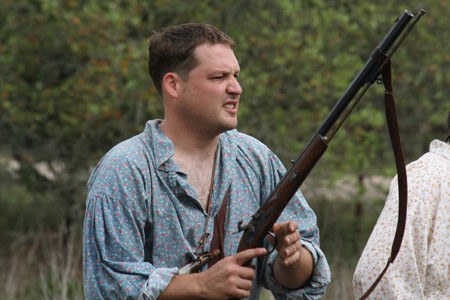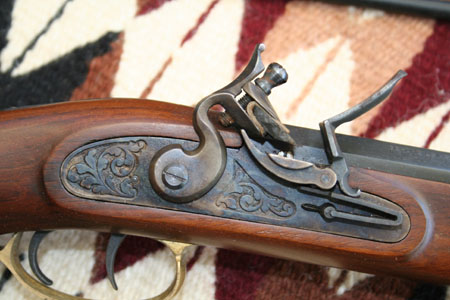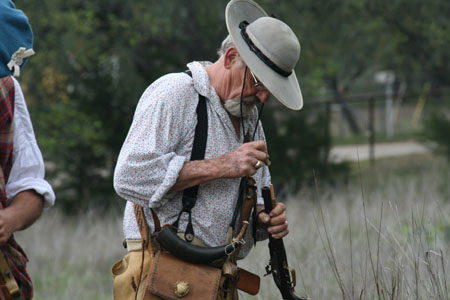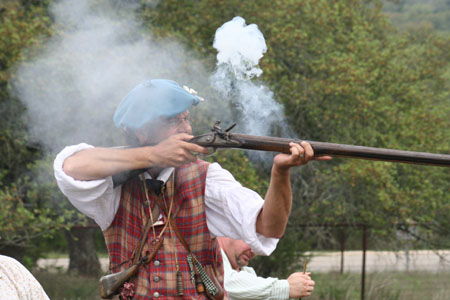Weapons of the Mountain MenA big part of Rendezvous is taking part in the different matches that take place there. Shooting rifles and pistols, throwing knives and hawks, and shooting a bow and arrow is all part of the fun. It is nice to have a good rifle and pistol, but these are not requirements for your first ‘Voo. Like other equipment, it is important to try things out before deciding on what you want. Take a look around and see what other people are shooting. If you are a hunter and plan on getting involved in hunting with your muzzleloading weapons, then this is a consideration as well. Small calibers are only suitable for small game. The Rifle There are a myriad of different muzzleloading rifles available to the modern shooter. From expensive custom guns to factory-produced ones, the choices are wide for the new ‘skinner. A quality weapon is always important, but this can be had without spending thousands of dollars. There are two main types of ignitions available on muzzleloading rifles – flintlock and percussion. Flintlock rifles have a small “flint and steel” set-up on the side of the gun (called a hammer and frizzen) to create a spark to ignite the charge in the barrel. A percussion action uses a small cap – not unlike the cap in a toy cap-gun – which sits on a nipple where it can be struck by the hammer. When stuck, the cap goes off with a small pop, igniting the main charge in the barrel. It is a little more complicated then that, but that’s the general idea. Flintlock ignition has been used since the 1600’s, but percussion ignition didn’t come on the scene until the 1820’s. What type of ignition your rifle has can be based on personal preference, or on the time period you want to emulate. Inline muzzleloaders, though they are still allowed for hunting during certain states’ muzzleloading season, have no place in primitive shooting. Inline muzzleloaders are strictly forbidden at most primitive events. A good rifle is the most important thing a man can own.
Smoothbore A smoothbore is very similar to a rifle, but unlike a rifle, there are not grooves running down the length of the barrel (called rifling, hence rifle!). This allows the weapon to fire musket balls or shot (a shotgun is an example of a smoothbore gun). Usually smoothbores are not accurate at far distances, but can be used for small game, such as rabbits, or to hunt birds. Smoothbores can be both flintlock or percussion and were often favored by Native Americans (Trade Guns) for their versatility of projectiles.
Pistols Muzzleloading pistols are also seen at Rendezvous and are used in the shooting contests that take place. Pistols are usually single-shot. They can be the same caliber as your rifle (making it easier to keep track of ammo), or a smaller cailber (useful in hunting to use for small game). The Colt Patterson revolver, an early revolver made in 1836, can be used at Rendezvous, though it’s presence at the original Rendezvous’ is doubtful.
Lead Balls The ammunition of choice at Rendezvous is the patched round ball. Though conical bullets are available for use in modern muzzleloading firearms, they are not historically accurate for this time period. Both rifle and pistol fire the lead round ball. Though lead round ball is commercially available, many ‘skinners prefer to make or “cast” their own lead balls. This is the process by which melted lead is poured into a bullet mould to create round ball. If this method is used, be advised that only pure lead can be used (no tire weights – they can damage your barrel). Always cast balls in a well-ventilated area, as lead produces very toxic fumes. Home-cast lead balls are not perfectly round, owing to a raised sprue caused by the bullet mould. Commercially manufactured balls are called swagged, meaning they have no such imperfections. Cleaning Your Smokepole I have tried every method under the sun to clean muzzleloaders and I change my mind about my favorite method about every other week. The black powder (no Pyrodex!) used in guns at Rendezvous can create a mess, but I wouldn’t trade the fun for a cleaner powder. Always ask a veteran black powder shooter for advice on cleaning your guns. Some recommeded cleaning solvents are:
Never let your guns sit for longer than necessary without cleaning them. Remember, a main ingredient in black powder (potassium nitrate) is a salt – it will rust-out your gun! Keep your weapon clean and well-oiled, with a clean, dry barrel. Here’s an article from Texas Parks and Wildlife on cleaning black powder guns. Shooting pouch The shooting pouch is what contains all of the items you need to make your muzzleloading weapons work. It can include:
Black powder is usually carried in a horn. Always have a spare ramrod. There are two types of people in the world – those who have broken a ramrod during a shoot, and those who will.
The Tomahawk and Throwing Knife For Rendezvous other weapons are needed as well. A tomahawk is the one of the most versatile tools a ‘skinner can have around the camp. It can be used to chop wood, drive stakes for the lodge, skin game, and of course as a throwing weapon for the ‘hawk throwing contest. For more information, click here. Unlike the skinning or butcher knife a mountain man carries on his belt or sash, the throwing knife is made of a heavier metal to mimic the weight of the tomahawk and avoid damage when thrown. For more information, click here. On to the next topic – Dressing the Part |




